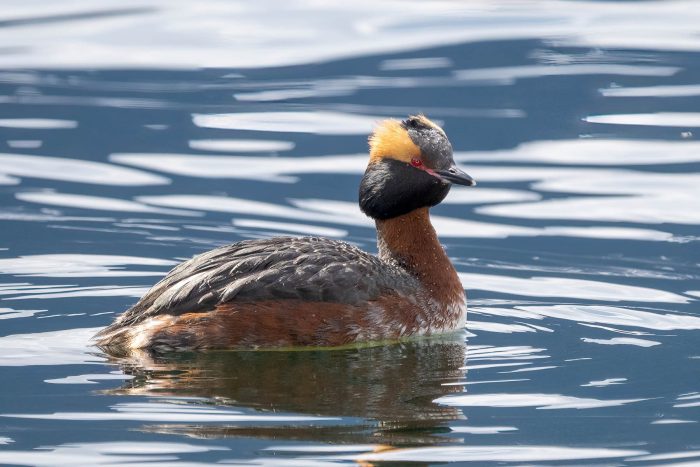Horned Grebe
Podiceps auritus
Horned grebes are black and white water birds that winter in the Chesapeake region.
This section shows one large critter image at a time. Use the thumbnails that follow to select a specific image to display here.

This gallery contains a grid of small thumbnails. Selecting a thumbnail will change the main image in the preceding section.
Appearance
During breeding season, horned grebes have a black head with a stripe of yellow feathers that extend from each eye to the back of their head and a reddish-brown body. During the nonbreeding season, they have a black body with a white neck and underbelly. They have red eyes.
Feeding
The horned grebe eats small fish, amphibians, crustaceans and insects. They catch prey in the water and flying insects above water. Insects make up most of their diet in the summer and fish and crustaceans are a primary source of food in the winter.
Predators
Horned grebes are not often preyed upon but they are most vulnerable during the nesting stage. Incubating adults are sometimes preyed upon by minks. Eggs are eaten by raccoons, crows, coots and gulls.
Flight
Grebes need to run across the surface of the water to become airborne.
Voice
The horned grebe is usually quiet during winter, but they will make a loud trill during the breeding season.
Reproduction and life cycle
Pairs form during winter of the spring migration. Males and females will begin a courting ritual as soon as they reach breeding territory. To court each other, birds will begin to mimic each other’s movements,swim together, present plants to each other and shake their heads at each other. Males and females will select a nest site and build a nest together. Nests are built with aquatic vegetation within 10 feet of the shoreline. Each clutch is three to eight eggs.
Males and females will take turns incubating the nest. Young can swim within one day but usually stay in the nest for longer. Parents will defend the nest aggressively. Parents will take turns caring for the young which will ride on their backs tucked under their wings even when the parents dive underwater. When young are about two weeks old, the parents may divide the brood and each care for their respective young. By four weeks, young leave the nest and pairs separate.
Did you know?
- Horned grebes can stay submerged underwater for up to 3 minutes traveling up to 600 feet.
- Horned grebe chicks often ride on their parents' backs nestled between their wings and sometimes even go underwater when their parents dive.
- They often eat their own feathers and will feed feathers to their young. The exact reason for this is unknown, but researchers believe the mat of feathers might serve as a filter to hold fish bones in their stomachs for a long enough period that they can be properly digested.
Sources and additional information
- All About Birds – The Cornell Lab of Ornithology
- Horned Grebe - Audubon Society
- Horned Grebe - Maryland Department of Natural Resources
